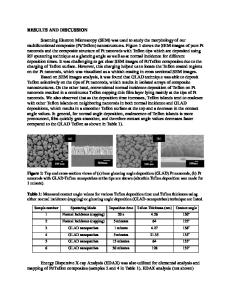Thin Film Microstructure Control Using Glancing Angle Deposition by Sputtering
- PDF / 188,737 Bytes
- 3 Pages / 612 x 792 pts (letter) Page_size
- 10 Downloads / 391 Views
MATERIALS RESEARCH
Welcome
Comments
Help
Thin film microstructure control using glancing angle deposition by sputtering J. C. Sit,a) D. Vick, K. Robbie, and M. J. Brett Department of Electrical and Computer Engineering, University of Alberta, Edmonton, Alberta, Canada T6G 2G7 and Alberta Microelectronic Corporation, Edmonton, Alberta, Canada T6G 2T9 (Received 10 August 1998; accepted 7 December 1998)
Thin films with microstructures controlled on a nanometer scale have been fabricated using a recently developed process called glancing angle deposition (GLAD) which combines oblique angle evaporation with controlled substrate motion. Critical to the production of GLAD thin films is the requirement for a narrow angular flux distribution centered at an oblique incidence angle. We report here recent work with low-pressure, long-throw sputter deposition with which we have succeeded in fabricating porous titanium thin films possessing “zig-zag,” helical, and “pillar” microstructures, demonstrating microstructural control on a level consistent with evaporated GLAD. The use of sputtering for GLAD simplifies process control and should enable deposition of a broader range of thin film materials.
It is well known that the columnar structure of thin films produced by oblique angle deposition is strongly influenced by atomic shadowing. In particular, at extremely oblique flux incidence angles a . 80± (measured relative to the substrate normal), the shadowing mechanism is greatly enhanced and, in a regime of limited adatom diffusion, results in a porous microstructure composed of columns inclined toward the vapor source.1–3 The recently developed glancing angle deposition (GLAD) method (Fig. 1) combines oblique angle evaporation with active control of the substrate orientation relative to the vapor source during deposition, allowing one to produce unique porous microstructured thin films.4 Examples include films possessing morphologies such as helical, or chiral, microstructures with unique optical properties,5,6 “zig-zag,”7 “pillar,” and periodically bent nematic8,9 (S-shaped) structures. Single material, multilayer rugate interference filters have also been made with GLAD.10 The GLAD technique has been demonstrated using thermal and electron beam evaporation for a wide range of materials including metals, metal fluorides and oxides, and semiconductors.4 In this article, we report the first GLAD thin films fabricated by sputtering. Using geometrical arguments, Tait et al.11 suggested that film porosity, as defined by intercolumn spacing in an obliquely deposited thin film, is a monotonically increasing function of the flux incidence angle a. At highly oblique angles such as those used in GLAD (a . 80±), the intercolumn spacing becomes a very strong function of a. Thus, small variations in a, such as those
a)
e-mail: [email protected] J. Mater. Res., Vol. 14, No. 4, Apr 1999
http://journals.cambridge.org
Downloaded: 14 Aug 2014
encountered with a wide angular distribution of incident flux, can result in large changes
Data Loading...










